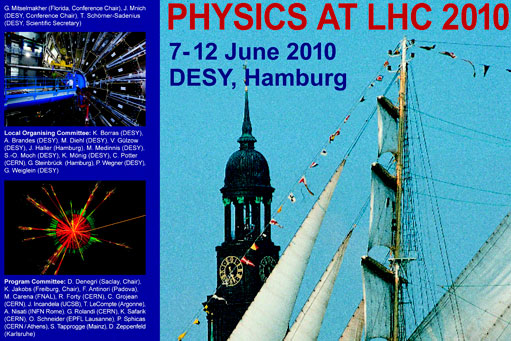
ATLAS e-News
23 February 2011
Summer conferences kick off
14 June 2010

Part of the poster for the Physics at LHC meeting
Last week, the first of the big 'summer conferences', Physics at the LHC (PLHC) took place at DESY in Hamburg, representing an important opportunity for ATLAS to present LHC data to the world. The weeks leading up to the conference were a flurry of frenzied activity, sleepless nights, corridor discussions, and double espressos. ATLAS e-News caught up with Deputy Physics Coordinator, Aleandro Nisati, in the week before the conference....
When asked what it took to be ready in time for PLHC, Aleandro's response is an emphatic: “A lot of effort.” ATLAS presented a total of 16 conference notes in Hamburg, broadly covering the whole physics spectrum that can be looked at so far, as well as detector performance studies.
“It's difficult to quantify how many persons we have per note,” Aleandro considers, “but if you count just for the notes preparation, without counting the work which has been involved for the infrastructure, it's maybe of the order of 20 persons per note.”
In Geneva and across the world, these 300-plus people worked with data taken between April 30th and May 17th 2010, although most notes were well underway before the end of that period. “It's a question of time optimisation,”
Aleandro explains. “While you are collecting data, you have to start to do the analysis, to see how the results look like, and compare against Monte Carlo predictions, to understand your detector… then you can adjust and optimise your analysis.”
The Editorial Boards for each note were responsible for ensuring that the collaboration's comments were heard and implemented. “They have really to scrutinise very deeply the note. It's the systematic work that you cannot expect from anyone else,” explains Aleandro, concluding: “The success of the note is closely related to how the Editorial Board acts.”
As for the conference itself, the aim in Aleandro's eyes is twofold: Challenging discussion between the LHC experiments, as they try to understand one another's' results – “A good sign of health in our community”; and interaction with people from the wider, non-LHC community – theorists, members of other experiments, members of past experiments – whose perspectives may significantly contribute to the discussion of current observations at ATLAS.
The aim is that the conference notes converge and become journal-published physics papers. Exposing the work to the wider physics community at this stage, and gauging their reactions, is an interesting step along the way – almost like an early peer-review process. Of course physics papers are some way off yet, but for now, progress is pleasing:
“ATLAS is proving that we can well face the situation. There is a lot of work. Not much more than expected, but the moment you try your skills in reality, then the situation is different,” says Aleandro. “But I'm satisfied, very satisfied. There are areas we need to improve, this is clear. But this is exactly what we need to learn how to make it better, because at the next step, ICHEP, we expect many more results.”
ICHEP, the International Conference of High Energy Physics, will take things up a notch. As well as there being more to present, to a more diverse audience, the material will need to be further developed, and build on what has just been shown at PLHC.
It may be tempting to think that the public stage of ICHEP will be a place for ATLAS to assert itself over 'the competition' in the eyes of the wider world. But in fact, Aleandro's aims are quite the opposite: establishing ATLAS as a flourishing experiment is of the utmost importance, but presenting a united front on the part of the LHC and all its experiments takes precedence..
“I see, and I hope this is an approach shared by the competition, it is important that we show not only how [our individual experiments are] doing well, but how the LHC project – the machine and all the experiments – is behaving,” he explains
“Finally this project, that is built around the strongest machine we've ever had, is producing results in a completely new energy domain, and that in the near future can bring our knowledge into a completely new world.”
 Ceri PerkinsATLAS e-News
|